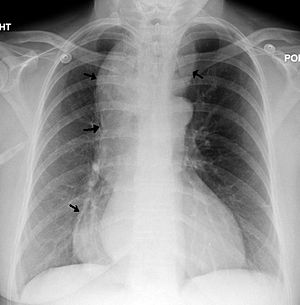Achalasia
| Achalasia | |
|---|---|
 |
|
| A chest X-ray showing achalasia ( arrows point to the outline of the massively dilated esophagus ) | |
| Classification and external resources | |
| Specialty | Thoracic surgery, general surgery |
| ICD-10 | K22.0 |
| ICD-9-CM | 530.0 |
| OMIM | 200400 |
| DiseasesDB | 72 |
| MedlinePlus | 000267 |
| eMedicine | radio/6 med/16 |
| Patient UK | Achalasia |
| MeSH | C06.405.117.119.500.432 |
Achalasia (/eɪkəˈleɪʒə/; + -chalasia "no relaxation") is a failure of smooth muscle fibers to relax, which can cause a sphincter to remain closed and fail to open when needed. Without a modifier, "achalasia" usually refers to achalasia of the esophagus, which is also called esophageal achalasia, achalasia cardiae, cardiospasm, and esophageal aperistalsis. Achalasia can happen at various points along the gastrointestinal tract; achalasia of the rectum, for instance, in Hirschsprung's disease.
Esophageal achalasia is an esophageal motility disorder involving the smooth muscle layer of the esophagus and the lower esophageal sphincter (LES). It is characterized by incomplete LES relaxation, increased LES tone, and lack of peristalsis of the esophagus (inability of smooth muscle to move food down the esophagus) in the absence of other explanations like cancer or fibrosis.
Achalasia is characterized by difficulty in swallowing, regurgitation, and sometimes chest pain. Diagnosis is reached with esophageal manometry and barium swallow radiographic studies. Various treatments are available, although none cures the condition. Certain medications or Botox may be used in some cases, but more permanent relief is brought by esophageal dilatation and surgical cleaving of the muscle (Heller myotomy).
...
Wikipedia
